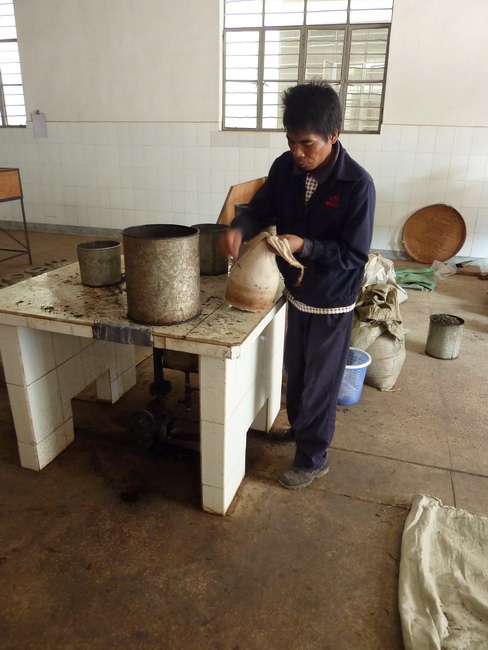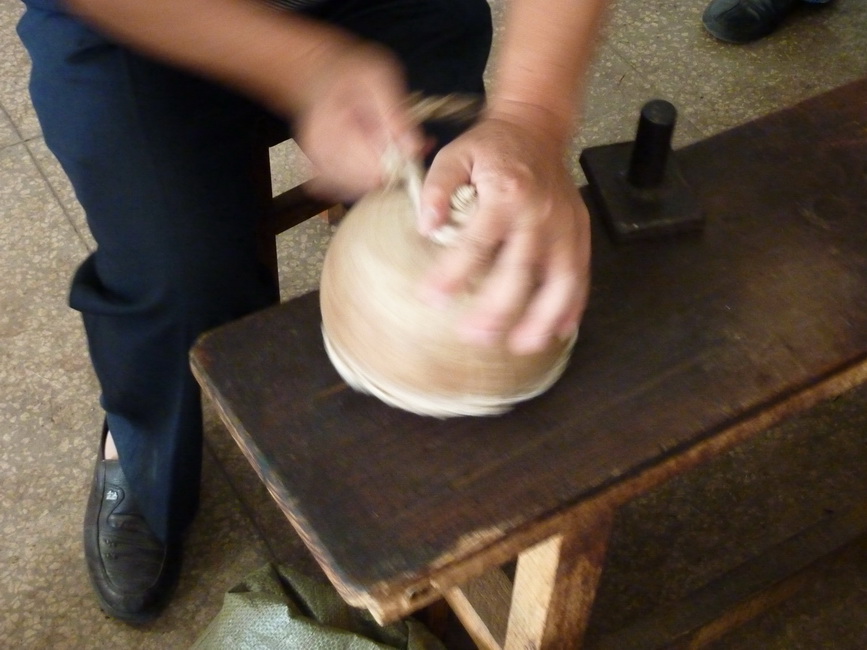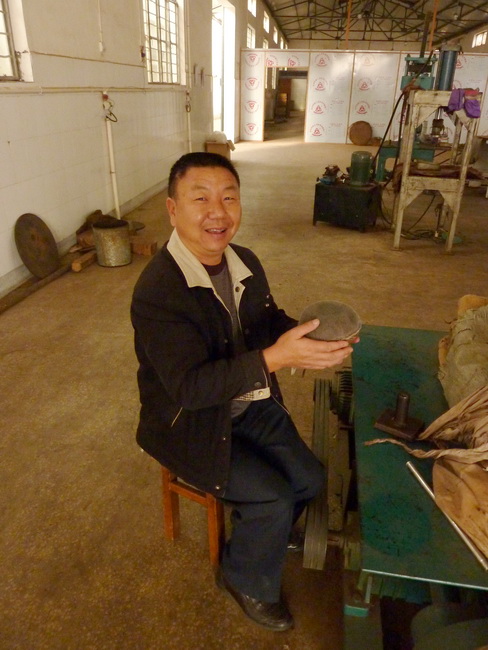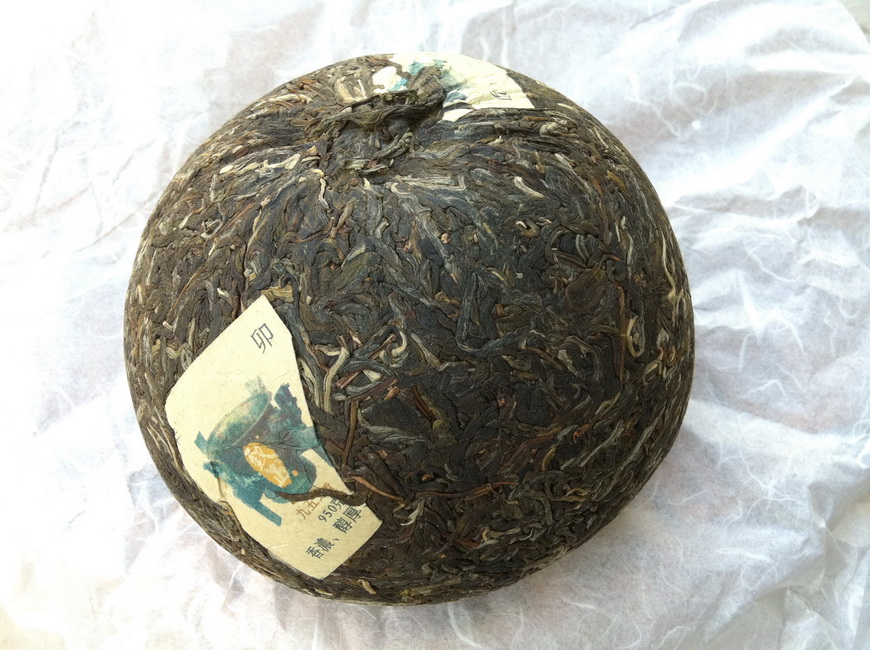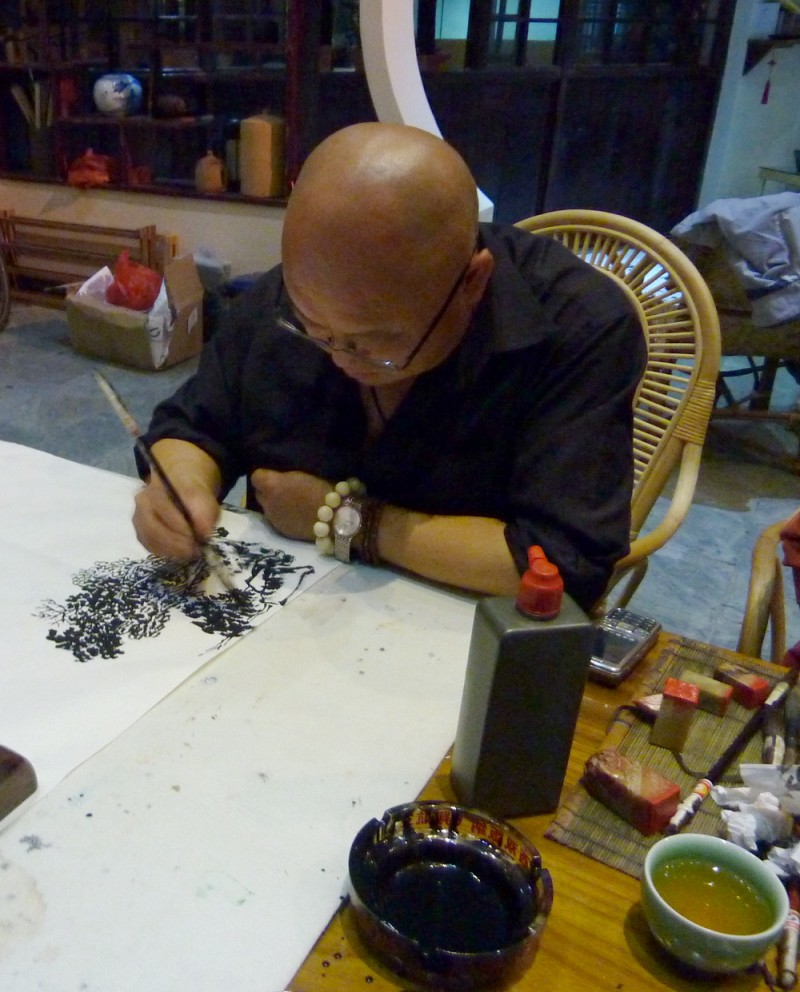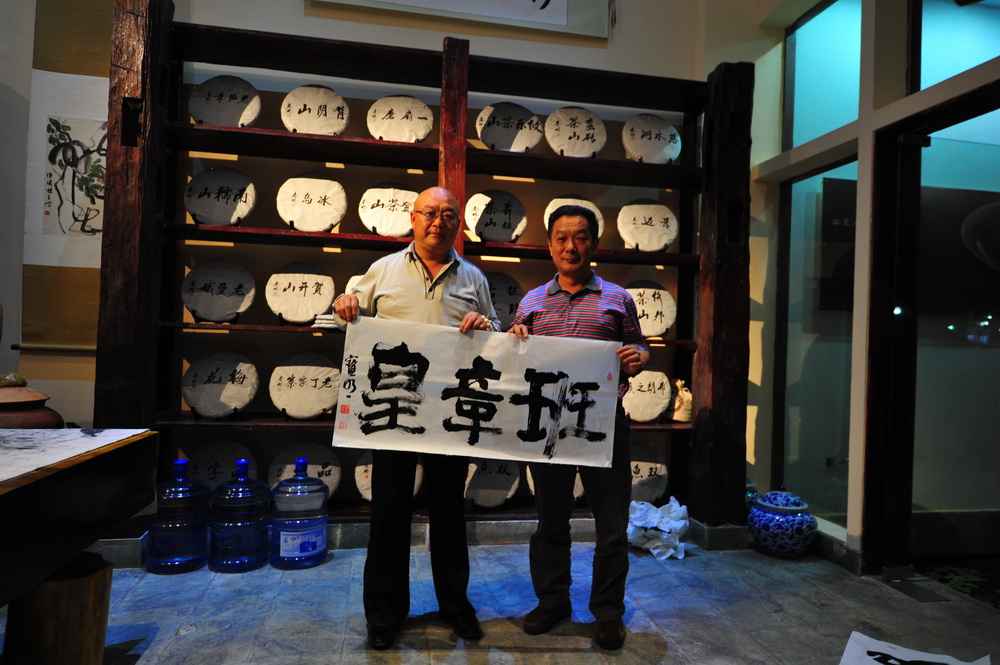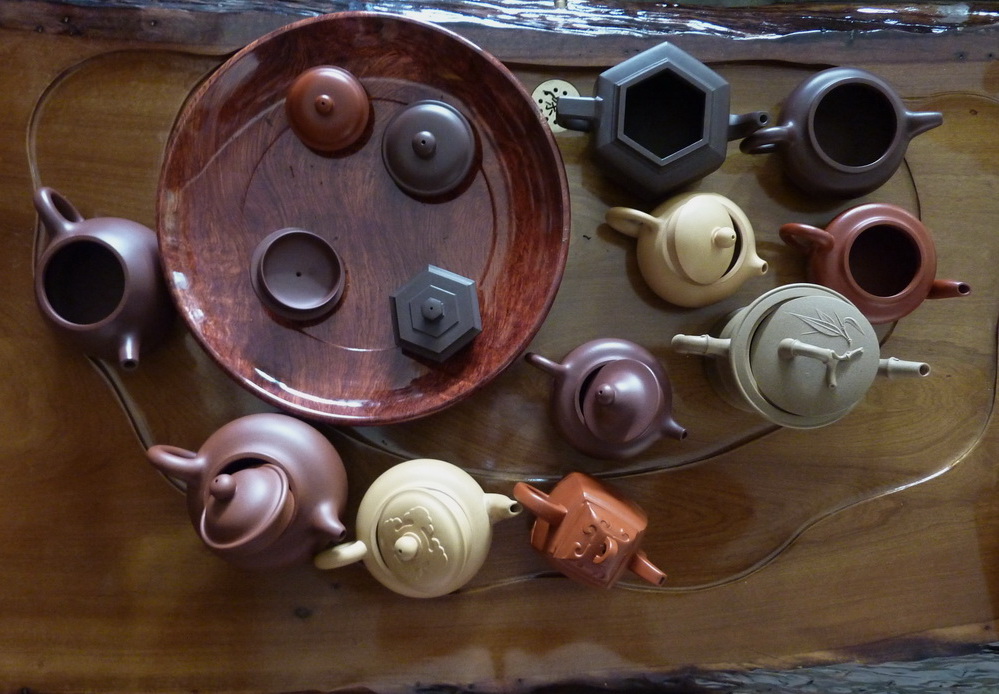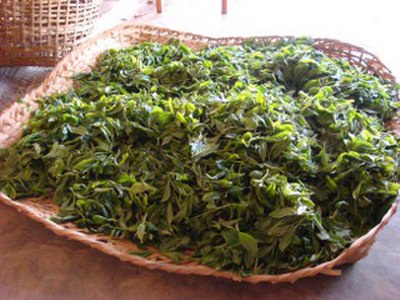The ultimate Puer tea knife. Made of agarwood by a friend in Guangxi. Turned, with a brass ferrule and steel pick. Something of a renaissance man (except he rides a Harley), he works in wood and clay, making tea trays and tea tools as well as ceramic water kettles.
Category Archives: People
Tea Heads
We’ve recently been going to Nan Chun Tea Factory in Menghai to get some work done. One day while we were there, HM discovered that they had previously made som ‘cha tou‘ or tea heads. This is basically a large ball – 1 or 2 kg – of tea. H.M managed to convince Nan Chun Cha Chang’s lao ban to personally make some cha tou out of some Nan Nuo Shan mao cha that we had left from this spring.
The weighed tea is steamed in the usual way and emptied into a cloth bag.
The tea is then rolled,
hammered,
and squeezed
into a near spherical shape
Nan Chun Tea Factory, Peng Lao Ban with a ‘tea head’
What you end up with is a pretty dense ball of tea – it could certainly do some damage if thrown in the wrong direction. (You’ve heard of Gunpowder tea – this is cannonball tea)
It has to be dried in a low temperature oven because, despite all the beating and squeezing, the moisture content in the centre is still relatively high so normal air drying would run the risk of the centre of the thing going mouldy.
The end result is rather pleasing – a solid lump of tea!
A Question of Wanting
Shizuto Masunaga is seen as the author of ‘Zen Shiatsu’ and Akinobu Kishi is said to have been his foremost student.
Some years ago, whilst I was studying shiatsu, I had the good fortune to study with Kishi on a couple of occasions. At the end of one day, a student asked a ‘nuts and bolts’ question about what to do if something was or wasn’t happening, which sounded like it required a ‘nuts and bolts’ answer. “This” said Kishi, “is a question about wanting.”
I have come more and more to the notion that this response could equally apply to tea.
Our preconceptions, which are cobbled together out of our experiences and our perceptions of those experiences, inevitably affect the way we perceive each new experience.
Let me try to clarify. We drink a tea for the first time, we form an opinion about it: we either like or we don’t like it, or we are indifferent to it. If it is one of the first two reactions, we will probably go on to determine what it is that we do or don’t like about it: the fragrance, the flavour, the bitterness, the sweetness, the aftertaste, etc.
But useful as the ability to judge is, there’s a problem with it: Even the same tea, can taste different at different times, not necessarily because the tea has changed (which it does, all the time) but because I’ve changed, my perceptions are not static, they are also in a state of flux. Sometimes, I drink a tea and it appears to be quite mild, but on another occasion, it can taste surprisingly bitter. If I drink tea in the morning, before eating, my perceptions are keener. If I drink after a eating, they are dulled considerably. Sometimes, much less obvious factors are going to colour our perceptions.
So we approach tea A, expecting it to taste like ‘Taste A’, but it doesn’t. It tastes like something else. If our opinion is fixed, we will doubtless be disappointed, but if we are open to the experience, not ‘wanting’ anything, we may see that there are qualities in the tea that are different from those we were expecting, but they are also good.
Drinking Tea
Zha Bao Ming was in the shop recently so HM wasted no time in procuring brushes, ink and paper for him to whip out some pictures to order. Here’s one of them, on the eternal theme of drinking tea in bucolic surroundings.
Peng Zhe, head of Xishuangbanna Tea Association was also here and had Zha Bao Min do a ‘King of Ban Zhang’ piece of calligraphy – doubtless destined for a tea cake wrapper next year!
Tea Pots
Make Tea According to What You See (More on wilting)
The expression in Chinese ‘kan cha, zuo cha‘ is saying ‘Make tea according to what you find, according to the situation.’ or as my grandfather used to say “Conditions determine.”
In light of some recent online discussion on withering tea, I thought it worth revistiting the topic here.
The debate centers around a couple of issues; Why are some Sheng ‘greener’ than others. The second issue is the supposition that the degree of ‘green-ness’ in a young Sheng Puer is determined largely by the length of time that the fresh leaves are withered.
This is a fair assumption, but it’s a partial reality. Wilt time, as previously said, will have some affect on the flavour and appearance of tea, but so also will the provenance, the type of trees, the season, the method and degree of drying and also the method of drying the pressed cakes. Last but not least, how long the mao cha is stored for prior to pressing, and where the tea is subsequently stored will also impact the teas flavour and appearance.
Two most common reasons that a Sheng Puer will seem more ‘green tea’ like are these:
Shaqing/frying temeperature: a higher temperature (say 90 + C) will do this.
The tea isn’t sun-dried and the temperature of drying is a little high.
Habits vary in different areas, and from season to season. Some farmers do not wilt at all, others wilt in the spring but much less in autumn. Wilting may be done for 40 minutes or for a few hours.
‘Kan cha, zuo cha‘ – A farmer is less looking at his watch than looking at the tea, feeling it, smelling it in order to decide when to start each step of the process – from picking to drying.
As teas from different regions and different farmers vary, so do ours. What works well for one tea, may not work well for another. No two teas are made exactly the same. What we strive for is to produce quality teas from different regions that maintain their uniqueness.
Conversations – On 'Where's it from?'
I was talking with a friend, Xiao Zhang, who runs a tea shop near ours. She had just got some Autumn Lao Ban Zhang mao cha for which she already had a probable customer. Whilst sampling the tea I asked her if she would be prepared to tell anyone who asked exactly where the tea was from – i.e. which tea farmer.
An emphatic ‘No’ was the answer, adding that she doubted if anyone locally would be willing to divulge which family or farmers they were getting their tea from.
Here’s the dilemma:
Developing long term relationships with tea farmers has some difficulties: If you have developed or are developing a relationship with a tea farmer, it’s still fragile, even when it may appear quite solid; you have an agreement to purchase a given quantity of, say first flush spring, tea from a given tea farmer but, if someone comes along behind you and offers more money for the same tea, it is tempting for the farmer to take it. In the Xishuangbanna area at least, no-one would be surprised at this kind of incident; tea farmers have gone, in 10 years or so, from more-or-less subsistence living in many cases, to having money to spare. But it is uncertain. It makes sense for them to ‘make hay when the sun shines’. The guy who buys your tea this year, might be gone the next.
The person who offers more money may have fewer requirements than you do and may, if they get the tea, walk away with a lesser quality tea than you might have got from the same farmer. But you still didn’t get the tea and may have to go back to ‘square one’ and find another source of tea that meets your requirements. This often can take considerable time and effort.
I realised in talking with Xiao Zhang that this highlights a fundamental difference in tea producers/suppliers attitudes:
Those sufficiently remote from the region likely need the names of mountain, village, tea farmer, to give credence to their merchandise. They also will understand the appeal that there may be for many westerners in buying a product which has a story behind it: this tea was made by tea farmer X in village Y, etc. even when the veracity of such claims may be hard to prove.
Chinese people generally, particularly here in a small city, in a rather less developed corner of China, are somewhat less removed from the sources of their food. The food supply chain is less of an abstraction than it has become in the west. Imported products are still relatively few, and even fruit and vegetables from neighbouring provinces are often eyed with suspicion. So, whilst local people in Jinghong are well aware of possible food growing practices ( it is quite common to bump into someone you know who will offer some fruit or other saying, “These are from my uncles’ trees, they don’t have any chemicals on them.”), the mantra of provenance for selling foodstuffs is less developed in China,and is less understandable than it is in the west.
Local tea merchants rarely need that credential, and their proximity to the growers means that they at least believe there is a chance that they can keep their relationship with a given tea farmer, and also, that they could lose it.
Suppliers remote from the producing region would, I suspect, rarely imagine that they have anything other than a tenuous link with the producer, so are less worried about others interloping. So, whilst the notion of complete transparency is honourable and justified, in reality, it would, for the time being at least, appear unworkable for the majority of tea merchants and small tea producers near centres of tea production.
There is another problem: we have a steady flow of people who come in the shop with ‘their hands in their pockets’, by which I mean, they do not openly declare their intentions. Sometimes, somewhat after the fact, we might understand that they have come to Xishuangbanna looking for tea, with the idea that they too can go up in the mountains and buy tea, take it home and sell it. If it happens to us, it happens to everybody.
And why not? They’re free to do so. But it would make little sense for anyone involved in the tea business here to give away too much information about their own contacts. The idea of a more open declaration is, for the moment, here in Xishuangbanna at least, rather remote.
More Where's it from?
Xiao Huang knows his Puer tea pretty well. He works in the local Bureau of Quality and Technical Supervision, but tea his passion. Sometimes he brings some of his own tea to our shop for us to drink. Recently, he has been asking for this year’s Bulang Peak, which he is convinced is really Lao Ban Zhang, but for some reason, we have chosen to hide the fact.
This is interesting for the fact that people’s notion of what Lao Ban Zhang, or any other tea for that matter tastes like, is highly variable; determined as it is by experience – i.e. which teas one has drunk, as well as the actual experience of drinking it – how one understands and assimilates the exerience of drinking tea.
Brewing Sheng Puer Tea – Science and Nature
Chen Lao Ban just came down from Kunming where he has a shop and we’re brewing a sample of autumn tea. He tells HM to move over and let him brew. “Your seat’s over there.” he says with an authoritative wryness.
He’s a big guy, but somehow manages to hunker over the chapan, focusing intensely on the brewing process.
How it started was this: someone had brought a bottle of water for us to try, and what was initially purely a test of the water evolved into a meditation on brewing parameters and equipment.
Different water, different pots, a gaiwan, different brewing styles, each time the result is different. We had, much earlier, dismissed the tea as being average, lacking in flavour (not surprising given the recent weather). Chen pronounces, with his usual style of scientifically peppered explanation, what precisley went wrong in the processing of this tea.
At times he seems to be something of a conjurer – but this description is misleading as it suggests a slight of hand which is inaccurate. There is no slight of hand.
If Chen Lao Ban is brewing a tea that he thinks is good or should be better, but has not shown it’s true colours, he will puzzle over how to adapt his brewing technique to get the best out of the tea.
He reminds me of a nature watcher perhaps, in the woods, hoping to see wildlife. He’s done his homework: he knows there are animals out there, he knows their habitat, he has a good idea about their habits, but it requires patience, skill, an understanding of the nature of the particular animal, and maybe a little cunning, to lure it out.
If one is not patient, one will see nothing. If one is patient, but not observant, one will also see nothing – keeping an open eye for any signs of movement is essential. Knowing where the animal may be, it’s temperament, and what skills to use to coax it out are essential, otherwise one will see nothing.
Of course, the precursor to this is knowing that you are in the right place to see something, in the right environment. If you misjudge the terrain, the search may well prove fruitless.
This is sheng Puer tea.
Post-conversation Conversation (On Wilting Shai Qing Mao Cha Part II)
I was recently talking with Wu Ya of Yunnan Scientific and Technical Publishing who, besides producing books on Puer tea, also publish the quarterly ‘Yunnan Puer Tea’ Magazine.
Wu Ya’s view echoed Tan’s: that it was not referred to in name in the past and that the wei diao period depended largely on how far a farmers trees were from the house. “What is important” he says “is that the fresh leaves are spread out and that they are not left overnight.” Adding that it was important for farmers to have a place (a small gazebo type shade structure) in their tea fields where leaves can be spread out in order that they stay cool whilst picking continues.
This view, not surprisingly perhaps, was reiterated in the Spring edition of Yunnan Puer Tea, which carried an article ‘Traditional and Modern Puer Tea Making Methods’.
The introduction differentiates traditional and modern methods as pre and post electrification. Essentially, tea making methods before and after 1956 (Three Big Transformations/san da gai zao). [This belies the earlier creation of a tea factory in 1938-39 in Nan Nuo Shan which introduced modern electric machines, but as they were essentially making black and green tea, we can perhaps ignore it in the context of the article. It is also of note that, because of the Nan Nuo Shan factory, set up by Bai Meng Yu, tea farmers in Nan Nuo Shan maintain they were ‘au fait’ with the concept of wilting much earlier than other areas, even though, at that stage, they were not making their own tea as they were obliged to sell their fresh leaves to the tea factory.]
Since wodui (wet pile) Puer tea production techniques were developed rather later in the 1970’s, the article does not consider shou cha in this comparison.
The article poses a central question: “What are the effects on the quality of traditional and modern Puer tea production methods?”
In translation it might read something like this:
“Comparison of the effects on quality of traditional and modern Puer tea production methods“
1. Wilting
Traditional method: Traditional production methods stipulate no particular requirement vis-a-vis wilting. If it happened, it was because the place where the tea was picked was far from where the tea was made, rather than being done deliberately. Thus, in traditional tea production, the craft of wilting was not stressed. Furthermore, there was no record or research of the function of wilting.
Modern method: Modern tea production methods, also have no specific requirements regards the wilting process, but some tea businesses, taking the practice from Wulong tea production, made ‘weidiao’ a set procedure in the production of Puer tea. The result is that Puer tea’s ‘kuse’ is reduced a little and the fragrance augmented. Another reason is that the fermentation process is accelerated and the rate of change in the tea is increased. Enzymes are a form of protein stored in living plants, they are one of the most powerful sources of transformation in organic matter.
People in the past referred to them as ‘yeast’ and believed that their function was to cause fermentation, today, modern science has confirmed that the function of enzymes is not fermentation, rather to act as a catalyst in living matter. In Puer tea, enzymes promote the release of fragrances and bring about other changes; enzymes in tea leaves have a direct relationship to the moisture content, temperature, humidity, etc.
After fresh leaves are picked, the process of dehydration is catalysed by enzymes. In the wilting process, between 10 and 16 hours, the activity of enzymes continuously increases up until 16 hours after which it starts to decline. *
The cataysing function of enzymes directly affects the formation of Wulong and Black tea. In Puer tea production, wilting can facilitate change and is beneficial to the teas quality.
Conclusion: Even though wilting is not considered a necessary process in both traditional and modern production, it is beneficial to the changes that take place and the quality of Puer tea, and is absolutely neccessary.”
*The article here is not suggesting that wilting in the Puer making process should be done for such a long time – it is merely describing the activity of enzymes in relation to time.
Yunnan Puer Tea Magazine, Spring 2011.
It would be easy to dismiss this as commercial patter serving the interests of big tea business so I thought it might be interesting to do a little ‘sondage’ of some publications to see if this point of view was generally supported.
A quick browse round publications in a local bookstore highlighted the broad acceptance of wilting shai qing mao cha for Puer tea. Pick up any Puer tea magazine and there’s always at least a couple of pictures of tea put to ‘wilt’. Of course, we could dismiss this as serving commercial interests, so here are a few more references;
Looking through some rather more official publications:
People’s Republic of China, International Standards GB/T22111-2008, Product of geographical indication (sic)- Puer tea.
“6.5.1 shai qing cha”
“xian ye tan fang – sha qing – rou nian – jie jue – ri guang gan cao – bao zhuang
Spread out fresh leaves – kill green – roll – finish – sun dry – wrap“
Here they use the phrase tan fang – to spread out. There is no further detail
So here:
Yunnan Tea Basic Production Skills (Yunnan cha ye chuzhi jishu)
This book describes 6 steps to produce ‘dian qing‘ a term sometimes preferred for shai qing mao cha – the raw material from which all Puer tea is made.
“Basic process of making sun dried tea (Shai qing cha ye chu jia gong)”
“2 – tan qing
After fresh leaves have been collected, they should be spread out to a suitable depth. 10-15 centimetres, allow the fresh grassy smell to disipate and the fragrance to augment. No moisture should be visible on the surface of the leaves. When the leaves have lost about 10% of their weight they are ready to fry.”
Here they use the phrase tan qing but the meaning is the same as tan fang and the objective – to reduce the moisture content in the leaves – is the same.
One could also dismiss these government publications on the basis that they also have interests to look out for, so I picked up a book I haven’t looked at in a while:
Liu Qin Jin is a fan of cooked Puer tea and no great fan of young Puer – he states in his book ‘Appreciation and Brewing of Puer Tea’ that Sheng cha should not even be called Puer tea until it has acquired the properties that are associated with aged Puer tea – i.e appropriate cake and broth colour and flavours/aromatic qualities that are typically associated with a well aged tea. He puts that at a solid 15 years.
He describes what he outlines as the ‘Steps in making Traditional Puer Tea’, where there is no mention of withering, but on the next page, where there is more detail of the steps involved, the first is ‘Spread out the fresh leaves’ (xian ye tan fang).
He recommends spreading the tea to a depth of 15-20 centimetres until the moisture content has been reduced to around 70%. This suggests a slightly longer wilting time than others propose.
So, by way of drawing some kind of provisional conclusion, we might note that wilting has become an accepted practice, albeit without very clear stipulations, particularly regard to time. There appear to be no indications that wilting Puer tea for Sheng Puer is in any way detremental to the tea, or to the ageing process of that tea. It is most certainly widely practiced to varying degrees and has been done so for several decades.



